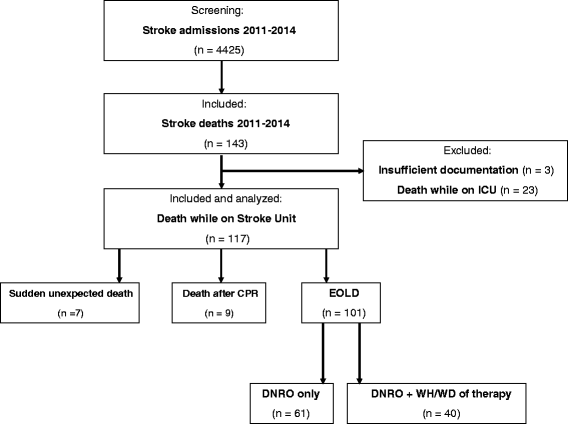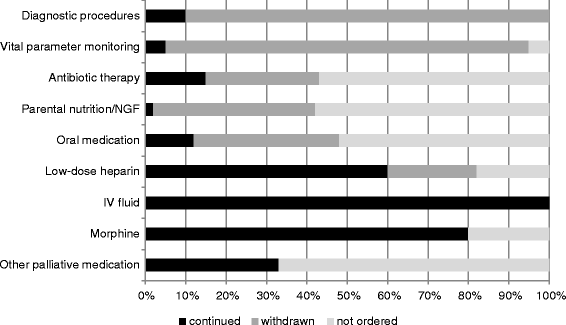End-of-life decisions in acute stroke patients: an observational cohort study
- PMID: 27044257
- PMCID: PMC4820928
- DOI: 10.1186/s12904-016-0113-8
End-of-life decisions in acute stroke patients: an observational cohort study
Abstract
Background: Crucial issues of modern stroke care include best practice end-of-life-decision (EOLD)-making procedures and the provision of high-quality palliative care for dying stroke patients.
Methods: We retrospectively analyzed records of those patients who died over a 4-year period (2011-2014) on our Stroke Unit concerning EOLD, focusing on the factors that most probably guided decisions to induce limitation of life-sustaining therapy and subsequently end-of-life-care procedures thereafter.
Results: Of all patients treated at our Stroke Unit, 120 (2.71%) died. In 101 (86.3%), a do-not-resuscitate-order (DNRO) was made during early treatment. A decision to withdraw/withhold further life supportive therapy was made in 40 patients (34.2%) after a mean of 5.0 days (range 0-29). Overall patient death occurred after a mean time of 7.0 days (range 1-30) and 2.6 days after therapy restrictions. Disturbance of consciousness at presentation, dysphagia on day 1 and large supratentorial stroke were possible indicators of decisions to therapeutic withdrawing/withholding. Proceedings of EOL care in these patients were heterogeneous; in most cases monitoring (95%), medical procedures (90%), oral medication (88%), parenteral nutrition (98%) and antibiotic therapy (86%) were either not ordered or withdrawn, however IV fluids were continued in all patients.
Conclusions: A high percentage of stroke patients were rated as terminally ill and died in the course of caregiving. Disturbance of consciousness at presentation, dysphagia on day 1 and large supratentorial stroke facilitated decisions to change therapeutic goals thus initiating end-of-life-care. However, there is further need to foster research on this field in order to ameliorate outcome prognostication, to understand the dynamics of EOLD-making procedures and to educate staff to provide high-quality patient-centred palliative care in stroke medicine.
Keywords: Advance directives; End-of-life decisions; Palliative care; Stroke; Stroke mortality.
Figures
Similar articles
-
Withholding or withdrawing life-sustaining treatments: an 8-yr retrospective review in a Spanish pediatric intensive care unit.Pediatr Crit Care Med. 2011 Nov;12(6):e383-5. doi: 10.1097/PCC.0b013e31820aba5b. Pediatr Crit Care Med. 2011. PMID: 21263365
-
Factors that influence advance directives completion amongst terminally ill patients at a tertiary hospital in Kenya.BMC Palliat Care. 2017 Jan 25;16(1):9. doi: 10.1186/s12904-017-0186-z. BMC Palliat Care. 2017. PMID: 28118824 Free PMC article.
-
Preliminary report of the integration of a palliative care team into an intensive care unit.Palliat Med. 2010 Mar;24(2):154-65. doi: 10.1177/0269216309346540. Epub 2009 Oct 13. Palliat Med. 2010. PMID: 19825893
-
End of life decision-making for cancer patients.Prim Care. 2009 Dec;36(4):811-23; table of contents. doi: 10.1016/j.pop.2009.07.006. Prim Care. 2009. PMID: 19913187 Review.
-
The effect of statutory limitations on the authority of substitute decision makers on the care of patients in the intensive care unit: case examples and review of state laws affecting withdrawing or withholding life-sustaining treatment.J Intensive Care Med. 2014 Mar-Apr;29(2):71-80. doi: 10.1177/0885066611433551. Epub 2012 Jan 17. J Intensive Care Med. 2014. PMID: 22257784 Review.
Cited by
-
Predicting long-term outcomes in acute intracerebral haemorrhage using delayed prognostication scores.Stroke Vasc Neurol. 2021 Dec;6(4):536-541. doi: 10.1136/svn-2020-000656. Epub 2021 Mar 23. Stroke Vasc Neurol. 2021. PMID: 33758069 Free PMC article. Clinical Trial.
-
Experience in Rehabilitation Medicine Affects Prognosis and End-of-Life Decision-Making of Neurologists: A Case-Based Survey.Neurocrit Care. 2019 Aug;31(1):125-134. doi: 10.1007/s12028-018-0661-2. Neurocrit Care. 2019. PMID: 30607828 Free PMC article.
-
Developing and testing inter-rater reliability of a data collection tool for patient health records on end-of-life care of neurological patients in an acute hospital ward.Nurs Open. 2023 Aug;10(8):5500-5508. doi: 10.1002/nop2.1789. Epub 2023 May 4. Nurs Open. 2023. PMID: 37141442 Free PMC article.
-
Outcomes, experiences and palliative care in major stroke: a multicentre, mixed-method, longitudinal study.CMAJ. 2018 Mar 5;190(9):E238-E246. doi: 10.1503/cmaj.170604. CMAJ. 2018. PMID: 29507155 Free PMC article.
-
Ultrasound of Optic Nerve Sheath Diameter and Stroke Outcomes.Crit Care Explor. 2021 Nov 11;3(11):e0565. doi: 10.1097/CCE.0000000000000565. eCollection 2021 Nov. Crit Care Explor. 2021. PMID: 34841250 Free PMC article.
References
-
- WHO Global Infobase: data for saving lives [https://apps.who.int/infobase/].
-
- Arias E, Kochanek KD, Xu J, Murphy SL. Mortality in the United States,2014. NCHS Data Brief 2015(229):1-8. http://www.cdc.gov/nchs/products/citations.htm. - PubMed
-
- Centers for Disease C, Prevention Place of death after stroke--United States, 1999-2002. MMWR Morb Mortal Wkly Rep. 2006;55(19):529–532. - PubMed
MeSH terms
LinkOut - more resources
Full Text Sources
Other Literature Sources
Medical



